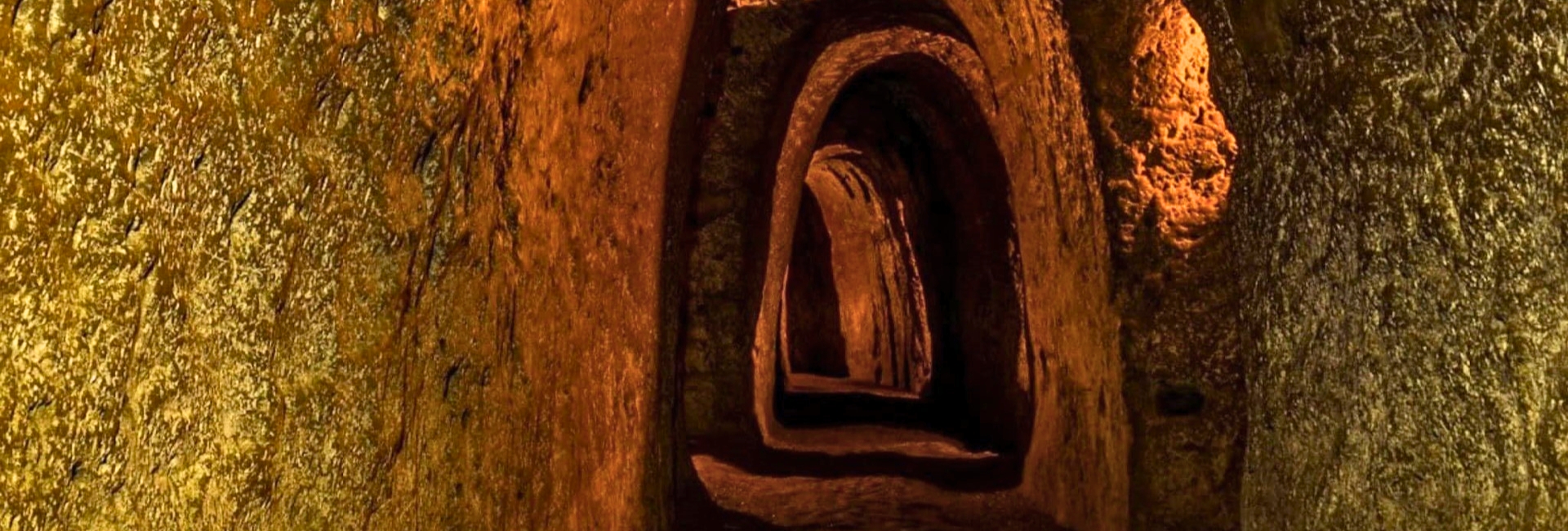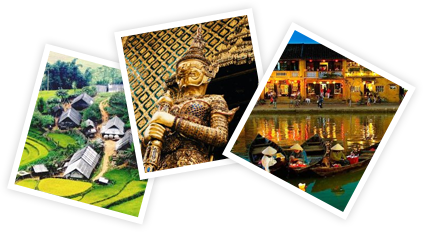The Cu Chi Tunnels stand as one of the most iconic attractions near Ho Chi Minh City, offering visitors a glimpse into Vietnam’s wartime history. This intricate network of underground passages serves as a testament to human ingenuity and resilience during one of the most challenging periods in Vietnam’s history. If you’re wondering whether to include this historical site in your Vietnam itinerary, this guide will help you decide and prepare for your visit.
How Far Is Cu Chi Tunnels From Ho Chi Minh?
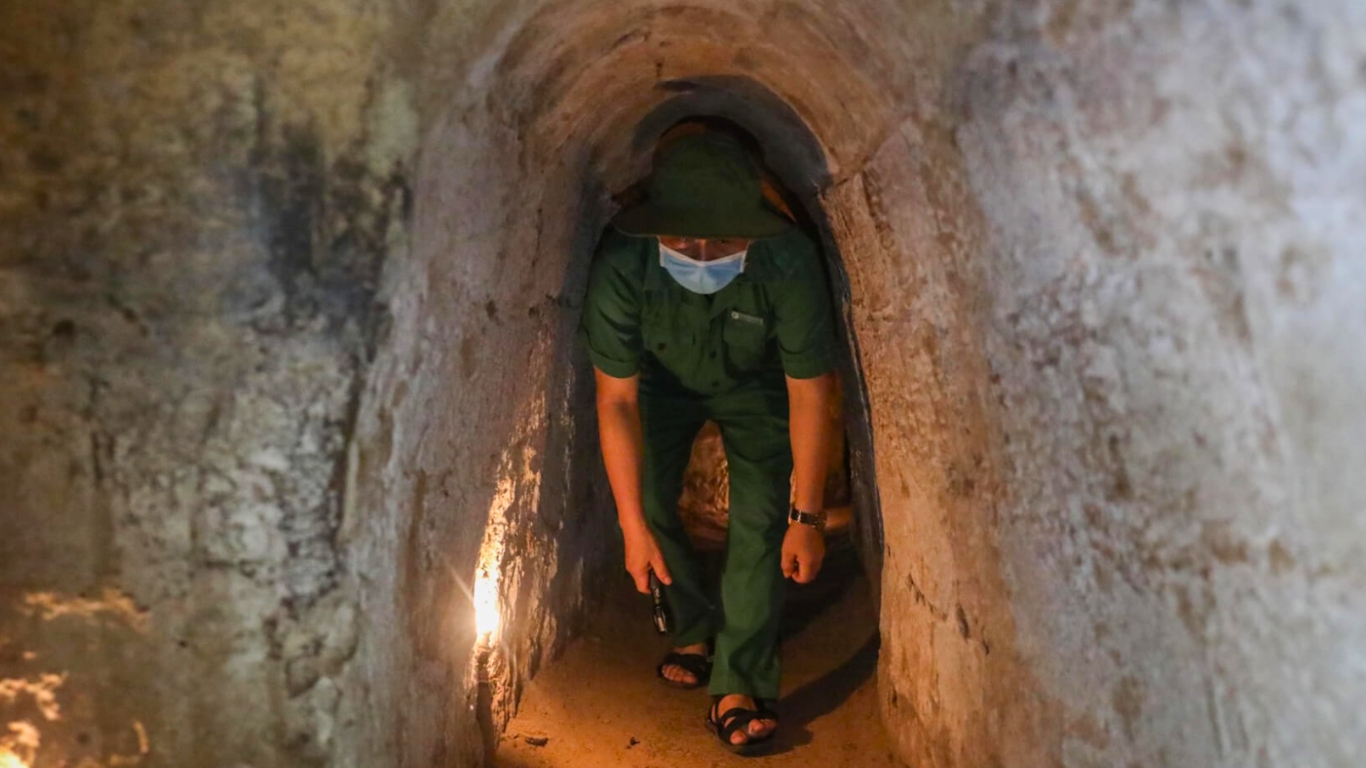
The Cu Chi Tunnels are located approximately 43-50 kilometers northwest of Ho Chi Minh City (formerly Saigon). The journey typically takes more than an hour by car or bus, depending on traffic conditions. Many visitors report that travel time can be surprisingly long, especially during weekday morning traffic, as you’ll be traveling on Highway 15, which can get congested.
The distance might seem relatively short on paper, but don’t be deceived—Ho Chi Minh City’s traffic can be quite intense. This makes the Cu Chi Tunnels perfect for either a half-day excursion or as part of a full-day trip from Saigon. Most tours depart in the morning to avoid the midday heat, returning to the city in the early afternoon.
So, Are Cu Chi Tunnels Worth Visiting?
In short: absolutely! The Cu Chi Tunnels offer a unique and educational experience that seamlessly blends history, culture, and adventure. This destination is particularly ideal for a Saigon day trip because it provides:
- A firsthand look at an engineering marvel created during wartime
- Immersive historical context that brings Vietnam’s past to life
- A balanced perspective on the Vietnam War (or American War, as it’s known locally)
- Physical experiences that help visitors understand the challenges faced by those who lived and fought in the tunnels
When visiting the Cu Chi Tunnels, you can expect:
- Guided tours explaining the tunnels’ historical significance
- Demonstrations of various booby traps and defense mechanisms
- Opportunities to crawl through specially widened sections of the tunnels
- Displays of war remnants and reconstructions of underground rooms
- Samples of simple foods eaten by tunnel inhabitants during the war
- Optional live firing of historical weapons at an on-site shooting range
- Beautiful natural surroundings that have reclaimed the once-devastated landscape
The History – What Were The Cu Chi Tunnels Used For?
The Cu Chi Tunnels have a fascinating origin story that dates back to the 1940s. Initially, the tunnels began as a modest network during Vietnam’s resistance against French colonialism. The Viet Minh (a revolutionary organization) dug these early passages by hand using rudimentary tools, initially covering just short distances.
After the French departed, leaving a power vacuum in the region, the tunnels took on new significance. As conflict with American and South Vietnamese forces intensified in the 1960s, the Viet Cong (VC) dramatically expanded the tunnel network. By the height of the Vietnam War, the system stretched an estimated 250 kilometers, reaching from the outskirts of Saigon all the way to the Cambodian border.
The tunnels were engineering marvels, especially considering they were created with basic hand tools. They featured:
- Multiple levels, with depths ranging from 3 meters (10 feet) to 10 meters (33 feet)
- Narrow passageways designed to fit the smaller frames of Vietnamese fighters
- Strategic air vents disguised as termite mounds to prevent flooding and provide oxygen
- Underwater entrances near rivers to allow for secret access
- Numerous hidden trapdoors camouflaged with leaves and dirt
These underground labyrinths served multiple vital purposes:
- Command centers for planning military operations, including the 1968 Tet Offensive
- Living quarters for soldiers and sometimes entire families
- Storage facilities for weapons, supplies, and food
- Field hospitals for treating wounded fighters
- Communication routes between villages and military bases
- Manufacturing workshops for weapons and traps
- Safe havens during bombing campaigns
The tunnels proved crucial to the Viet Cong’s guerrilla warfare strategy, allowing them to control when and where battles would occur and significantly complicating American military efforts in the region.
Life in the Tunnels
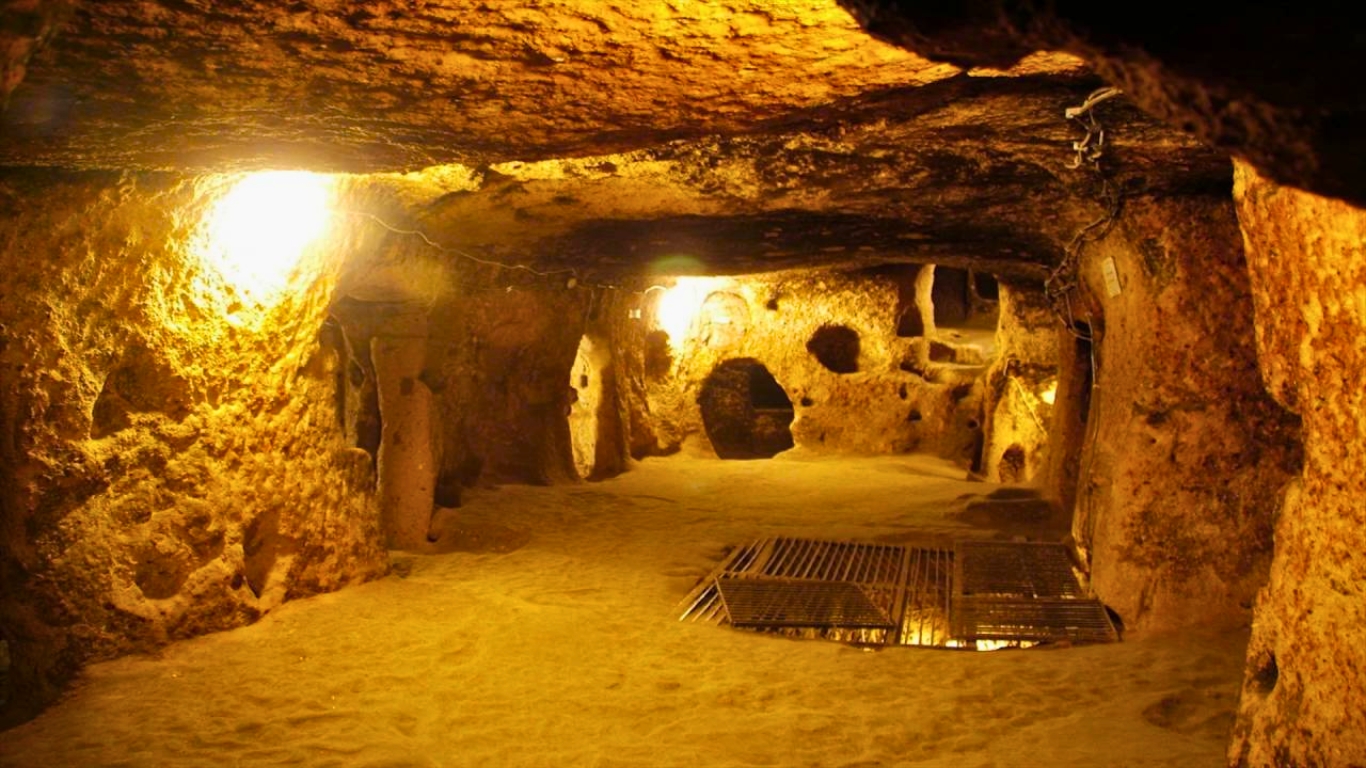
Life within the Cu Chi tunnel network was extraordinarily difficult. The conditions were harsh and dangerous, with soldiers and civilians enduring tremendous hardships while living underground:
The tunnels were perpetually hot, humid, and had limited ventilation. Breathing was difficult, and the air was often stale and foul. American soldiers coined the term “Black Echo” to describe the oppressive conditions inside.
Space was extremely confined, with most tunnels measuring only about 80-120 centimeters (31-47 inches) high and 60-80 centimeters (24-31 inches) wide. People lived in cramped quarters, often unable to stand upright for days or weeks.
The darkness was nearly complete, with few light sources available. Residents would typically use small oil lamps sparingly to conserve fuel.
Disease was rampant, particularly malaria, which was the second-highest cause of death after combat wounds. According to captured reports, at any given time, up to half of a Viet Cong unit might be suffering from malaria, and virtually all had significant intestinal parasites.
The tunnel dwellers faced constant danger from:
- Cave-ins caused by bombing
- Poisonous gas pumped in by American forces
- Flooding during the rainy season
- Wildlife, including venomous centipedes, scorpions, snakes, and rats
Food was scarce and simple. The primary diet consisted of tapioca (cassava) and other easy-to-grow crops that could be cultivated near tunnel entrances. Most cooking was done at night or very early morning to prevent smoke from revealing tunnel locations.
For women, life was especially challenging during menstrual periods, with limited hygiene options and no ability to leave the tunnels during heavy bombing campaigns.
Despite these extreme conditions, the tunnel inhabitants displayed remarkable resilience and ingenuity. They developed systems for water collection, created designated areas for different activities, and established routines that allowed them to survive for years in this underground world.
The Booby Traps
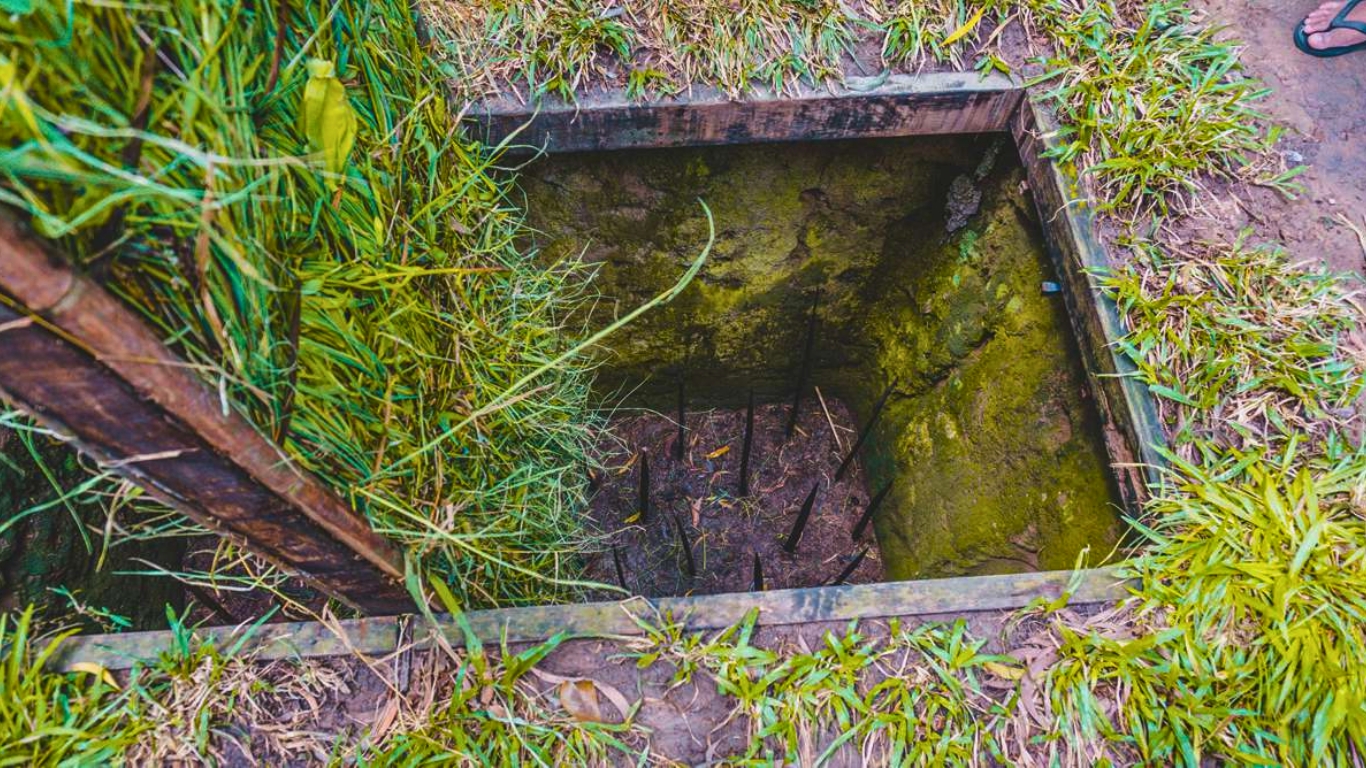
One of the most infamous aspects of the Cu Chi Tunnels was the extensive use of booby traps. These were designed not necessarily to kill but often to maim and wound, which would require more resources from the enemy to care for injured soldiers.
The Viet Cong created these deadly devices using simple materials, often recycling metal from unexploded American bombs and artillery shells. Some of the most common traps included:
- Punji Stake Pits: Concealed holes filled with sharpened bamboo stakes, sometimes smeared with animal feces to cause infection in wounds.
- Swinging Door Traps: Spring-loaded devices with metal spikes that would slam into an intruder’s torso when triggered.
- Ankle Traps: Hidden mechanisms that would clamp around a soldier’s foot, often embedded with spikes.
- Drop Traps: Camouflaged pits with sharp spikes at the bottom, designed to impale anyone who fell in.
- Tripwire Traps: Nearly invisible wires that, when tripped, would release spikes, arrows, or other projectiles.
The psychological impact of these traps was significant. American soldiers had to move cautiously through the jungle, creating constant stress and fear. The guides at Cu Chi today often demonstrate how these various traps worked, giving visitors a sobering understanding of the guerrilla tactics employed during the war.
Some of the traps were specifically designed to wound rather than kill, based on the strategic calculation that an injured soldier would require the assistance of others, effectively removing multiple fighters from combat with a single trap.
Unique Experiences When Visiting
A visit to the Cu Chi Tunnels offers several unique experiences you won’t find elsewhere:
Crawling Through the Tunnels: Perhaps the most memorable experience is the opportunity to crawl through a 100-150 meter section of tunnel that has been specially widened for tourists. Even these enlarged sections remain challenging and give visitors a taste of the claustrophobic conditions. Most people emerge with newfound respect for those who lived in the much narrower original tunnels.
Firing Historic Weapons: The site features a shooting range where visitors can fire various weapons used during the Vietnam War, including AK-47s, M16s, and machine guns. While this costs extra (around 55,000-60,000 VND per bullet with a minimum purchase of 10 bullets), many visitors find it a unique, if loud, experience.
Sampling Wartime Foods: Visitors are often offered steamed tapioca with sesame salt and pandan tea—the same simple fare that sustained the Viet Cong soldiers during the war.
Watching Documentary Films: Several viewing huts at the site show documentary footage about the war and the tunnels. These provide important historical context, though many guides now recommend specific YouTube videos they believe offer more balanced perspectives.
Trying to Spot Camouflaged Entrances: Guides demonstrate how tunnel entrances were disguised, often challenging visitors to spot the almost invisible trap doors before they’re revealed.
Witnessing the Breathing Mounds: You can see the camouflaged ventilation mounds that provided air to the tunnels below, ingeniously disguised to look like termite hills or natural terrain features.
Suggested Cu Chi Tunnels Day Trip
There are several ways to incorporate the Cu Chi Tunnels into your Vietnam itinerary. Here are two excellent options:
Option 1: Half-Day Cu Chi Tunnels Experience
Morning: Departure and Arrival
- Depart for your late morning flight to Ho Chi Minh City, formerly known as Saigon, the vibrant Pearl of the Far East.
Midday: Cu Chi Tunnels
- Upon arrival, you will be picked up and driven out of the bustling city to the Cu Chi Tunnels. These remarkable tunnels were manually excavated by Viet Cong soldiers, serving as a secret military base during the Vietnam War. This site is essential for anyone interested in learning about the history of the Vietnam War.
Afternoon: Check-In and Exploration
- After your visit, return to the city in the late afternoon to check into your hotel. Take some time to explore the vibrant streets and local attractions at your leisure.
Option 2: Combined City Tour and Cu Chi Tunnels
Morning: Breakfast and City Tour
- Enjoy breakfast at your hotel.
- At 8:15 AM, embark on a half-day city tour of Ho Chi Minh City. Highlights of the tour include:
- The Old Post Office: An architectural gem reflecting French colonial style.
- Notre Dame Cathedral: A stunning basilica surrounded by lush greenery.
- Independence Hall: A pivotal site in Vietnam’s history.
- War Remnants Museum: A powerful reminder of the Vietnam War.
- Ben Thanh Market: Experience the hustle and bustle of this iconic marketplace.
Afternoon: Lunch and Cu Chi Tunnels
- After the city tour, enjoy lunch at a local restaurant in the heart of Ho Chi Minh City.
- Following lunch, travel to Cu Chi District to visit the famous historical site, the Cu Chi Tunnels. Explore the intricate network of underground tunnels used by Viet Cong and guerilla fighters during wartime.
Late Afternoon: Return to Saigon
- Walk along the narrow paths of the tropical forest in Cu Chi to witness remnants of the Vietnam War, gaining insight into its impact on the region.
- After your exploration, return to your vehicle for the drive back to Saigon in the late afternoon.
Feel free to spend the evening at your leisure, soaking in the vibrant atmosphere of the city.
Indochina Voyage also provides these Cu Chi Tunnels day tours as well as Vietnam tours, and you can customize them until they suit you best. All you need to do is contact our team to discuss your preferences and requirements.
Before You Go
Here is some information that may be helpful for you before going:
Opening Hours and Entrance Fee
- The Cu Chi Tunnels are open daily from 7:00 AM to 5:00 PM
- Entrance fee: Approximately 110,000 VND for adults (about $4-5 USD)
- Guided tours typically cost $20-30 USD, including transportation from Ho Chi Minh City
Are The Cu Chi Tunnels Claustrophobic?
Yes, the tunnels can definitely trigger claustrophobia, even in the sections that have been widened for tourists. The original tunnels were extremely narrow, and even the enlarged tourist sections require crouching and crawling in dim lighting. If you have claustrophobia, consider these options:
- You can still visit and enjoy most of the site without entering the tunnels
- Try entering just a short distance and then turning back
- There are multiple exit points along the tourist tunnel routes
Can You Go Inside The Cu Chi Tunnels?
Yes, visitors can go inside sections of the tunnels that have been specifically prepared for tourism. These sections have been:
- Widened from the original 60-80cm to about 120cm
- Reinforced with concrete for safety
- Equipped with dim lighting
- Provided with exit points at regular intervals
However, even these modified sections can be challenging to navigate and require a moderate level of fitness. If you have mobility issues, respiratory problems, or severe claustrophobia, you might want to skip the tunnel crawling portion of the tour.
Additional Tips
- Wear comfortable clothing – You’ll be walking through forest areas and potentially crawling through tunnels
- Apply insect repellent – The area is surrounded by jungle
- Bring water – The climate is hot and humid year-round
- Consider a morning tour – To avoid the afternoon heat
- Bring small bills for the entrance fee, souvenirs, and shooting range if interested
- Choose between sites – Ben Dinh (closer to HCMC, more commercial, wider tunnels) or Ben Duoc (further away, more authentic, fewer tourists)
- Book with a reputable tour company – A knowledgeable guide makes a significant difference in the experience
The Cu Chi Tunnels represent an important chapter in Vietnam’s history and offer visitors a unique opportunity to understand the ingenuity, hardship, and determination that characterized this period. While the journey there might be lengthy and some aspects challenging, particularly for those with claustrophobia or mobility issues, the historical significance and educational value make it well worth the visit for most travelers to Ho Chi Minh City.
By approaching your visit with respect and an open mind to learning about this complex period of history, you’ll gain valuable insights into Vietnam’s past and the resilience of its people—insights that will likely remain with you long after your trip has ended.
>> For off-beat seekers: Saigon Off the beaten path: Top 15 Offbeat Activities for Curious Travelers
Thuy Dang – From Indochina Voyages Team

